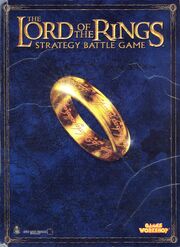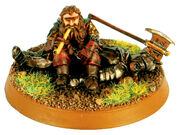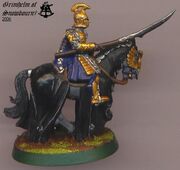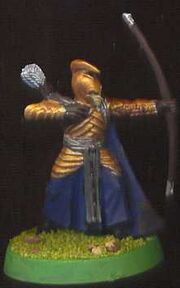
The complete "One Rulebook to Rule them All"
The Lord of the Rings Strategy Battle Game (abbreviated LOTR SBG), often referred to by players as simply Lord of the Rings, is a tabletop miniature wargame produced by Games Workshop, based on The Lord of the Rings films and novels. It was initially released in 2001 to tie in with the movie The Fellowship of the Ring. New box sets with updated rules were also released for The Two Towers and The Return of the King movies. Later Games Workshop also began to add content that was featured in the original novels but not in the film adaptations (e.g. Tom Bombadil, Radagast and Glorfindel) called the 'Shadow and Flame' collection. This was generally supported, but there was mixed reactions when Games Workshop invented characters and wrote histories for lands Tolkien wrote little about, such as Harad.
Games Workshop released a complete new edition of the rules and rulebooks in September 2005, entitled "One Rulebook to Rule them All". However, it was subjected to scrutiny because it lacked the rules for the Army of the Dead and Golfimbul.
In December 2012, a new range was released based on the The Hobbit trilogy.
Licensing
Games Workshop has the rights to produce a skirmish wargame based on the films and also on The Lord of the Rings and The Hobbit novels by J.R.R. Tolkien. (The rights to produce a roleplaying game version of the films were sold to another firm, Decipher, Inc.). Though they also have the rights to produce a Battle of the Five Armies game, another company already owned the rights to the one-inch scale normally used by Games Workshop. For this reason, the game was done in 10mm scale for the normal warriors, and "heroic" scale for the named characters.
Games Workshop has not acquired the rights to the Silmarillion, which is currently the exclusive property of the Tolkien Estate. However, they were somehow permitted to use Eorl the Young and Khamul the Easterling (from Unfinished Tales) in their The Two Towers and A Shadow in the East Supplements. [2]
In the 1980s, Games Workshop also had an unrelated series of Lord of the Rings models. However, these were far below the standard of quality for the current range, and are not permitted for use in Lord of the Rings tournaments because of the legal situation in Games Workshop's current license. [3]
The Hobby
Collecting

Similar to "Warhammer Fantasy" players, Lord of the Rings players commonly collect and paint one army (or more) of their choice and find opponents (with similarly collected armies) to play against. Armies can be built up from through the purchase of boxed sets (usually having 10 or 12 plastic miniatures in each) or "blister packs" (usually containing no more than four finely detailed metal/citedal finecast miniatures) to build up a reasonable sized fighting force. Others simply collect the miniatures because they like the way they look. One popular way of collecting is through "Battle Games in Middle Earth" - a DeAgostini magazine which comes with a free miniature (some of which are exclusive to the publication) and painting guide. [4]
As such, there are a wide variety of miniatures in the ever-growing range, including promotional miniatures, such as "Gimli on Dead Uruk-hai" (commemorating the 2005 Summer Campaign). Recently, Games Workshop began to discontinue some of their metal miniatures, so that they could replace them with plastic miniatures. They justified this action by saying that the quality in plastic moulding has improved to a point where they are almost as detailed as metal, and that plastic is cheaper to produce. However, there was much complaint when they inexplicably retired the popular "Boromir Captain of the White Tower" miniature, and it was later brought back into production.
Many prefer Lord of the Rings to Warhammer because it is less "cartoony" than Warhammer, and say that the armies look nicer and more realistic when fully painted. In contrast, Warhammer players frown on Lord of the Rings because they think the miniatures are geared too much towards skirmish and have armies that are not of a large enough scale.
Modelling

Mixing parts from different models is a popular method of conversion (a converted Maeglin miniature [1]).
Since the models are hand-painted and assembled by the player, players are often encouraged to design their own paint schemes as well as using the pre-designed ones displayed in the various books. They are also encouraged to further modify their miniatures using parts from other kits and models (known as "bitz" to players), modeling putty, or whatever the modeler can scrounge up. These conversions are often entered into contests at sponsored tournaments and similar gaming events, such as the One Ring Awards.
Terrain is a very important part of play. Though Games Workshop makes terrain kits available, many hobbyists prefer to make their own elaborate and unique set pieces. Common household items like soft drink cans, coffee cups, Styrofoam packing pieces, and pill bottles can be transformed into ruins from the Second Age, woodland terrain, or the rocky wild of Middle-earth with the addition of plasticard, putty, and a bit of patience and skill.
However, due to the licensing agreements between New Line Cinema and Games Workshop, pieces of models for the Lord of the Rings Strategy Battle Game are not allowed to be combined with other model lines for official tournaments or conversion awards. The same is true for pieces from other manufacturers.
Current state of play
Overview of Rulesets
As of September 2005, the rules for Lord of the Rings Strategy Battle Game are in their fourth edition The first three editions of the rulebooks were released with the Lord of the Rings films, but Games Workshop used White Dwarf and various Supplements as an outlet for characters that were in the book but not the film. The current edition, the "One Rulebook to Rule them All", contains the entire set of rules updated and presented in a single large volume, including those of previous supplements. The three older editions are to be re-released in updated supplements. Currently, the official editions of Rulebooks and Supplements include:
- The Fellowship of the Ring Rulebook, for the first installment of the films, recently released as an updated supplement
- The Two Towers Rulebook, for the second installment of the films
- The Return of the King Rulebook, for the third and final installment of the films
- Shadow and Flame Supplement, featuring rules for characters from the novel not included in the film
- The Siege of Gondor Supplement, featuring siege rules for the game, centering around Minas Tirith
- The Battle of the Pelennor Fields, featuring rules for larger battles involving Mumakil and Haradrim
- The Scouring of the Shire, featuring rules for smaller battles involving Hobbits
- A Shadow in the East, featuring rules for Easterlings, Khandish Chariots, and new good heroes.
- Fall of the Necromancer, featuring rules for new evil creatures, the necromancer, and wood elves.
- The Ruin of Arnor, telling the story of the fall of the northern kingdom, including rules for an arnorian army, dunedain, and unqiue evil creatures.
- Khazad-Dum, featuring Durin, new dwarven units, and goblin prowlers.
- The Fellowship of the Ring, a journey book that more so tells the story of LOTR than gives new rules, although a few new statlines are introduced.
- The Two Towers, the second journey book which continues the story, and contains new statlines (more than the fellowship journey book)
- The Return of the King The Return Of The King is the third journeybook and contains more painting guides, scenarios, and a larger amount of unit lists than the previous two expansions)
- Gondor in flames This source book contains all the rules necessary to field Gondorian siege weaponry and the rules for most of the units of Gondor.
- Harad This source-book features the warriors of Harad, the Corsairs, and the warriors of Muhad.
- Mordor This source-book focuses on the armies of Mordor, and introduces the Black Númenóreans as new characters.
In February 2012, Games Workshop released a new set of Sourcebooks along with several new miniatures in order to replace some of the older Sourcebooks for the game, they lacked the painting and modeling sections presented in the older books and introduced new units. The Khandish Mercenary list and individual themed lists (Minas Morgul, Cirith, Morranon) where effectively re-worked or removed completely from the books. This release appears to be an attempt to re attract players before the release of the Hobbit film.
- Kingdoms of Men
- Free Peoples (Elves, Dwarves, Ents, Hobbits)
- Moria and Angmar
- Mordor
- Fallen Realms ( Easterlings, Harad, Isengard, Khand)
For materials done under the previous iteration of the rules, there exist errata and FAQ files, to ensure potential rules conflicts between editions are resolved universally.
There are also a number of unofficial Supplements that have been made by fans.
- Note: coming soon a new expansion containing rules for two weapon fighting and more.
- The Age of the King, a completed supplement suggesting what might have happened in the Fourth Age
Troop Types

A Last Alliance High Elf miniature
There are two types of troops: Warriors and Heroes. Heroes have characteristics which set them apart from the Warriors they lead, and can be named or unnamed characters: Aragorn, Frodo, Captains, etc. Warriors are the core of the army: Warriors of Harad, Riders of Rohan, Men of Gondor, etc. Each army must be either Good or Evil, and can only include miniatures from that side (each model is named in the rules as being either Good or Evil). Armies include:
- Elves
- Gondor
- Rohan
- Dwarves
- Hobbits
- Angmar
- Moria Goblins
- Isengard
- Mordor
- Harad
- Easterlings
- Mahud
- Corsairs of Umbar
- Variags of Khand (No longer supported by Games Workshop)
Game Systems
The games uses a points system similar to Warhammer Fantasy, which itself has many similarities with Tolkien's works. It is primarily a skirmish game, but can be played in varying scale:
- Scenario - These are based on an event in the book or film, and the armies are predetermined and fought using Special Scenario-specific Rules
- Points Match - These are played between two forces of equal size, generally of 500 Points each (which is usually no more than 50 miniatures per side).
- War Party - This is a stricter form of the Points Match, using forces of no more than 250 Points.
- Battle Company - This is an experience-based system which is played out with no more than 25 miniatures.
The Turn system game is played using four phases:
- Priority Phase
- Move Phase
- Shoot Phase
- Combat Phase
Differences with Warhammer
One of the key differences between the game and Warhammer, however, is that in Lord of the Rings, the players take turns playing out one phase at a time, but in both forms of Warhmmer, each player plays their full turn before the other player has their turn. Warhammer miniatures are usually grouped into units; Lord of the Rings allows freedom of movement for each individual miniature. For this reason, the perfected turn and movement systems of LoTR SBG can be considered more realistic than that of Warhammer Fantasy or Warhammer 40K. However, LoTR SBG is impractical for large games- especially since combats are fought model-to-model rather than unit-to-unit, however in Warhamer fantasy (where movement trays make moving hundreds of models easier) and warhammer 40k (where the Apocalypse expansion makes huge games practical), large games are encouraged. This Difference was eliminated however when the War of the Ring was introduced as a separate game style in which movement trays are used to carry out larger battle scenarios
Online Community
There are a large number of small, unofficial websites and forums for Lord of the Rings players, such as "The Last Alliance", with over 9000 registered members, and "The One Ring", with over 1800 registered members.
On June 1 2005, Games Workshop launched their UK-based Annual Online Summer Campaign: "The War of the Ring Online Campaign". The Campaign was successful, with 3007 registered participants. Games Workshop also introduced the "Wrath of Umbar" Roadshow, with custom-built corsair models and gaming boards being brought to various cities in the United Kingdom. When the Campaign formally ended on September 8, Good emerged the victor. The combined total of the 14 weeks was 27239 recorded games. The Forum closed shortly after, giving way to a smaller Campaign based in Canada. However, the Campaign was nowhere near the scale of its UK counterpart, and was ignored by many who viewed it as a "watered-down" version of the original.
Trivia
- Four of the LoTR SBG designers were in the Return of the King film as Rohirrim at the Battle of the Pelennor Fields: Alessio Cavatore, Brian Nelson, Alan and Michael Perry. They can be seen near the Oliphaunt when Peregrin Took goes searching for Meriadoc Brandybuck among the debris from the battle, and are also on the base of Games Workshop's Mumak miniature. [5]
- Games Workshop created two miniatures of Peter Jackson as a hobbit from Bree: one is owned by the director, and the other is kept on display at GW headquarters in England.
| People: Faramir · Sauron · Witch-king of Angmar · Gollum · Elrond · Frodo Baggins · Samwise Gamgee · Meriadoc Brandybuck · Peregrin Took · Gandalf · Aragorn II · Legolas · Gimli · Boromir · Galadriel · Elves · Hobbits Locations: Middle-earth · Gondor · Mordor · Rohan Other: Mithril · Middle-earth Strategy Battle Game · The Fellowship of the Ring: Being the First Part of The Lord of the Rings · Works inspired by J. R. R. Tolkien · The Lord of the Rings · The Lord of the Rings (1978 film) · Ainulindalë · Tolkien vs. Jackson · Tengwar · Quenya |
External links
Template:Space
- Unofficial War of the Ring website a monument to the participants of the War of the Ring Campaign
Template:Lotr featured
